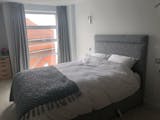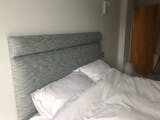A custom headboard is not just a functional element in your bedroom; it’s also an opportunity to express your unique style and add a personal touch to your space. Whether you're aiming for a modern, minimalist vibe or a more traditional, cosy feel, designing your own headboard allows you to tailor every detail to your taste. This guide will take you through the essential steps to create a headboard that enhances your bedroom’s aesthetics and fits seamlessly into your décor.
Step 1: Determine the Size of Your Headboard
The first and most important step in designing your upholstered headboard is determining its size. The size of the headboard should be proportionate to both your bed and the overall size of your room. Here are some common headboard sizes based on bed dimensions:
- Single Bed: Typically 90 cm wide, a headboard for a single bed should be 90cm wide depending on style.
- Small Double: A small double headboard would typically measure 120 cm.
- Double: For a double, the headboard is usually 135 cm wide.
- King Bed: A king sized headboard is approximately 150 cm wide.
- Super King Bed: Super king headboards should be 180 cm wide.
Apart from width, height is another important factor. A taller headboard creates a dramatic effect, drawing attention to the bed as a focal point. If you have a small room or a low ceiling, a shorter headboard might be more suitable, as it will maintain a balanced look without overwhelming the space.
Step 2: Choose Your Headboard Shape
Once you've determined the size, it’s time to decide on the shape of your headboard. The shape plays a crucial role in defining the style of your bedroom, and it can range from simple to ornate depending on your personal preference.
Here are some popular headboard shapes:
- Rectangular: The most straightforward and versatile option, perfect for minimalist and modern designs.
- Curved: A gentle curve at the top adds a soft and elegant touch, making it a popular choice for traditional and transitional bedrooms.
- Wingback: This style includes "wings" on either side of the headboard, often associated with a luxurious and cosy feel, making it ideal for traditional or farmhouse aesthetics.
- Camelback: Featuring a gentle, arching curve that dips down in the middle, this shape is perfect for those seeking a subtle yet sophisticated design.
- Button-Tufted Shapes: If you choose to add tufting, the headboard shape can be customized to complement this feature, often resulting in a regal or vintage look.
Think about the shape that resonates most with your desired bedroom style. Modern and minimalist spaces often benefit from clean, straight lines, while more traditional or eclectic designs can embrace curves and ornate silhouettes.
Step 3: Pick the Right Upholstery Material
Choosing the right fabric for your upholstered headboard is crucial, as it sets the tone for the entire room. Upholstered headboards come in various fabric options, each bringing a distinct texture and feel to your space. Here’s a look at some popular choices:
- Linen: Linen is a versatile fabric that offers a natural, breathable feel. Its light texture and neutral tones work well in both minimalist and traditional settings. Linen adds a touch of elegance while being easy to maintain.
- Velvet: Velvet creates a luxurious, plush appearance that’s perfect for adding drama and opulence to a bedroom. This fabric is ideal for those wanting a more glamorous, regal look, especially in rich, deep hues like emerald green, navy, or burgundy.
- Cotton: A durable and soft fabric, cotton is easy to clean and maintain, making it perfect for modern or casual bedrooms.
- Leather or Faux Leather: Leather or faux leather provides a sleek, polished look and is often associated with modern, minimalist, or industrial designs. It's easy to clean and adds a sophisticated touch.
- Suede: Suede offers a soft, matte finish and brings warmth to any room. It works beautifully in contemporary or mid-century modern designs, providing a cosy yet upscale feel.
When selecting your fabric, think about its durability, comfort, and how it will pair with other elements in your bedroom. For instance, a velvet headboard might add a sense of luxury to an otherwise minimalist room, while a linen headboard would complement a more natural, boho aesthetic.

Featured Base Product: The Jamesia Headboard
Step 4: Select Your Colour Palette
The colour of your upholstered headboard can either be a bold statement piece or a subtle complement to the rest of your décor. The choice of colour should reflect your personal style while maintaining harmony with the room’s overall colour scheme.
- Neutral Tones: Beige, grey, white, and soft pastels are timeless and versatile options that work well in most bedrooms. A neutral-toned headboard allows you to easily switch up bedding and décor without clashing.
- Bold Colours: If you want your headboard to be the focal point of the room, consider bold colours like deep blues, rich greens, or even jewel tones. These colours create a dramatic effect and can instantly elevate a space.
- Patterns: For a unique and personalized look, you can opt for patterned fabrics. From geometric prints to floral designs, a patterned headboard adds texture and visual interest, especially in a minimalist room where other décor elements are understated.
Take into account your existing furniture, bedding, and wall colour when selecting your headboard colour. You want to achieve a cohesive look that feels both balanced and stylish.
Step 5: Decide on Additional Features and Customization
Customization is where your headboard truly becomes unique. From tufting to nail head trims, here are some features you can consider to give your upholstered headboard a custom flair:
- Button Tufting: A classic technique often used in upholstered furniture, button tufting adds a timeless, elegant feel. It’s commonly seen in more traditional or glam bedroom styles and pairs beautifully with velvet or linen fabrics.
- Nail head Trim: Nail head trim is a decorative feature that adds a sophisticated, polished touch to your headboard. It works well with leather or faux leather and can give a more tailored, traditional look.
- Embroidery or Patterns: For a truly bespoke headboard, consider adding embroidered details or a patterned fabric. This is perfect for eclectic or artistic styles where creativity and personal expression are key.
- Wingback Sides: If you want to create a more enclosed, cosy feel, a wingback headboard is an excellent option. The additional sides frame the bed, making it appear grander and more luxurious.

Featured Base Product: The Ilex Headboard Style
Step 6: Consider the Installation and Mounting
Now that you’ve designed your custom upholstered headboard, it’s important to think about how it will be mounted. There are two primary options:
- Wall-Mounted Headboards: Wall-mounted headboards are attached directly to the wall behind the bed. This option offers stability and allows you to create a taller or wider headboard without worrying about it being attached to the bed frame. Wall-mounted headboards are ideal for larger or more intricate designs.
- Bed Frame-Mounted Headboards: These headboards are attached to the bed frame and tend to be easier to install. They offer flexibility in size and design, as they can be switched out more easily if you decide to update your bedroom décor in the future.
Be sure to measure carefully and ensure that the installation is secure, especially for larger or more elaborate headboards.
How a Custom Upholstered Headboard Enhances Bedroom Aesthetics
An upholstered headboard isn’t just a piece of furniture; it’s a design statement that can completely transform the look and feel of your bedroom. Here’s how a custom headboard can enhance your space:
- Creates a Focal Point: The headboard is often the first thing people notice when they walk into a bedroom. A well-designed headboard draws attention and sets the tone for the rest of the room’s décor.
- Adds Texture and Warmth: Upholstered headboards introduce softness and texture, which can make a room feel more inviting and cosy. Whether you choose plush velvet or sleek leather, the fabric adds an extra layer of visual interest.
- Balances the Room: A custom headboard can help balance the proportions of your room. For example, a tall, dramatic headboard can make a small bedroom feel more spacious by drawing the eye upward, while a wider headboard can make a large room feel cosier.
- Personalizes Your Space: Since the headboard is custom-made, it reflects your unique taste and personality. Whether you prefer a minimalist look or a more traditional style, a custom headboard allows you to create a space that feels distinctly yours.
Conclusion
Designing a custom upholstered headboard is a rewarding process that allows you to create a one-of-a-kind piece tailored to your bedroom’s aesthetics and your personal preferences. From selecting the size, shape, and fabric to adding special features like tufting or nail head trim, the possibilities are endless. By following these steps and considering how each element contributes to the overall look, you can create a headboard that not only enhances the beauty of your room but also serves as a true reflection of your style.







